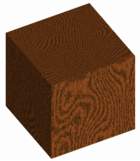TAPESTRY: The Art of Representation and Abstraction
Texture Maps: Procedural Maps
What's it all about?
.gif)
Procedural maps (aka "solid textures"), like image maps, answer the question "what is happening on this part of the surface." Unlike simple image maps, which answer the queestion by consulting a database (the image), procedural maps perform a computation. That is, the surface attributes are a function of the (u,v) coordinates, plus anything else we know, like the surface normal. This makes it possible for the resulting pattern to
- wrap continuously around the object, and
- show orientation.
The most obvious uses of these textures are for solid wood or marble, etc.
 A procedural wood texture (click for an enlarged view).
A procedural wood texture (click for an enlarged view).
Look ma! no seams
Another feature of procedural textures is that they don't "run out of data" and need to fall-back on repeating "strips" of patterns. The pattern can go on and on and on ....
.gif)
The set-up is the same as for the LOOKUP (or simple) texture map. The difference is that because we are using a mathematical calculation for deciding what color to return at the position (u,v), we can extend the calculation indefinately (i.e., the pattern does not have to repeat), and we can take advantage of additional information, such as the surface normal vector, to do things like generate wood-grain that shows as rings on one face, and as face-grain elsewhere (in contrast to image textures, which look like veneer).
 A procedural wood texture (click for an enlarged view). Note how "side grain" and "end grain" are different, and how individual growth rings carry-over from one face of the cube to the others.
A procedural wood texture (click for an enlarged view). Note how "side grain" and "end grain" are different, and how individual growth rings carry-over from one face of the cube to the others.
 Another procedural pattern. Procedural patters don't need to repeat, and usually do not.
Another procedural pattern. Procedural patters don't need to repeat, and usually do not.
Last updated: April, 2014
